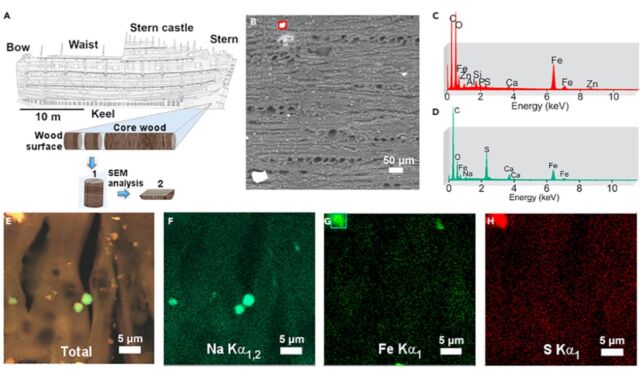A Tudor rose —
Polyethylene glycol applied to hull for preservation is also breaking down into acids.
Jennifer Ouellette
–

Enlarge / The hull of Henry VIII’s favorite warship, the Mary Rose, and many thousands of recovered artifacts are housed in the Mary Rose Museum in Portsmouth, England.
Johnny Black
Henry VIII’s favorite warship, the Mary Rose, sank in battle in 1545. The shipwreck was successfully raised in 1982, along with thousands of artifacts, and conservationists have worked tirelessly to preserve the ship’s remains ever since. Now a multidisciplinary team of researchers has applied a new X-ray technique to analyze the ship’s wooden hull. According to a new paper published in the journal Matter, the hull is rife with zinc-containing nanoparticles that are contributing to its deterioration.
“It was especially exciting to get a glimpse into the history of the Mary Rose in the years since it sank,” said co-author Simon Billinge, a materials scientist at Columbia University who has a joint appointment at Brookhaven National Laboratory. “The zinc sulphide deposits come from anaerobic bacteria living in the wood as it sat sunk in the seabed—they are essentially bacteria poop. Our results were like a microscale archeological dig where, by studying the location and composition of the deposits, we could see how the bacteria colonized the wood and what they ate.”
As we’ve reported previously, the earliest-known reference to the Mary Rose appears in a January 29, 1510, letter ordering the construction of two new ships for the young king: the Mary Rose and her sister ship, dubbed the Peter Pomegranate. Once the newly built ship had launched, Henry VIII wasted no time defying his advisers and declaring war on France in 1512. The Mary Rose served the monarch well through that conflict, as well as during a second war with the French that ran roughly from 1522 through 1525, after which it underwent a substantial overhaul.
Alas, the ship’s luck ran out during yet another outbreak of war with France. During the Battle of the Solent, French ships tried to land troops on English soil in the straits just north of the Isle of Wight. On July 19, 1545, contemporary accounts report that the Mary Rose suddenly heeled over to the starboard side—perhaps due to a sudden shift in the wind—and the crew couldn’t correct the imbalance. Because the gunports were open, water rushed in and sank the Mary Rose. The exact cause of the sinking is still a matter of heated debate, but it was likely a convergence of factors, including overloading, crew error, and that sudden gust of wind.
For many years after it was recovered, the hull was housed in dry dock as conservationists worked to preserve the structure. That required keeping the entire thing saturated with water, initially. Later, they applied a polyethylene glycol solution to add mechanical stability. The ship’s remains are now displayed in the official Mary Rose Museum, built right over the original dry dock in Portsmouth.
Synchrotron radiation is proving to be a powerful tool in developing effective conservation strategies. Synchrotron radiation is a thin beam of very high-intensity X-rays generated within a particle accelerator. Last year, high-energy X-ray analysis of chain-mail links salvaged from the wreckage by a team of British scientists revealed that the material composition of the armor is similar to modern brass alloys.
There were also traces of lead and gold whose origin has yet to be decisively determined. The authors suggested that many of those traces possibly came later; during World War II, the Portsmouth Dockyard was the target of heavy bombing, which deposited lead, mercury, and cadmium, for instance, into the Solent waters.

Enlarge / Schematic of the Mary Rose wood sample and X-ray imaging results.
K.M.O. Jensen et al., 2021
Now conservators have turned their attention to analyzing the wood hull of the Mary Rose. There is evidence from prior studies of metal sulfides from anaerobic bacteria and corroded iron fixtures. Under atmospheric conditions, those sulfides can oxidize into acids as well, further adding to the hull’s deterioration.
Billinge and his fellow authors opted to combine X-ray diffraction tomography with pair distribution function (PDF) analysis—a technique dubbed “computed tomography PDF” that has been used previously to study catalysts and batteries. This enabled the researchers to image how X-rays scattered through representative core samples and then make pixel-by-pixel comparisons of the resulting images. These methods revealed detailed information about the location of the elements of interest, as well as detailed structural information.
The authors found that the wood hull is now riddled with zinc sulfide nanoparticles. In addition, they found significant polymer deposits—evidence that the polyethylene glycol solution applied to the hull for preservation purposes is now starting to break down and form acids, which also threaten the continued mechanical integrity of the hull.
Currently, the team is using its new technique to conduct further studies on the role zinc might play in the degradation of wood cellulose, as well as the impact of the corroded iron and sulfur. Understanding this will help the researchers figure out how to neutralize the zinc-based nanoparticles in particular. “This also has an impact on assessing artifacts recovered from the Mary Rose hull, including brick, leather, and textiles, which to date are not as extensively studied,” the authors wrote.
DOI: Matter, 2021. doi.org/10.1016/j.matt.2021.09.026 (About DOIs).

